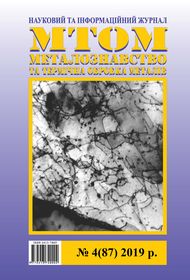Main directions of improving the development of technology for manufacturing products from polymer composite materials by the method of winding
DOI:
https://doi.org/10.30838/J.PMHTM.2413.241219.42.599Keywords:
composite polymeric material, winding, pressure, fibre, reinforcing scheme, prepregAbstract
Abstract. The development of scientific and technological progress in mechanical engineering, energy, aerospace and other industries is unthinkable without the creation of new structural materials that can improve the most important parameters of engines, machines and mechanisms, assemblies, devices and increase their mass performance, reliability, service life of products and reduce their material consumption. Products and aggregates from polymer composite materials (PCM) can be obtained in various ways. In industrial production, the most widely used method of winding and pressing. Pressing can be carried out using a mixture of preliminarily fiber and a polymer binder. One of the most promising methods of forming products and assemblies from a variety of plastic is the method of winding with fiber, due to the fact that it creates the required filler structure in the factories depending on their shape and operation characteristics. All areas of effective use of polymer composite materials are reflected. This article discusses the technological capabilities and applications of traditional and new varieties of the method. Even, the results of an analysis of the prospects for the development of manufacturing technologies for products and aggregates from polymer composite materials using the winding method are presented. There are methods of dry and wet winding. Consider these winding methods. Winding is carried out on a mandrel mounted on a machine with numerical control. This method is also called the spiral winding method. Existing approaches to the development of mathematical models are described and created for the manufacture of complex structural elements, including products and an assembly with a curved spatial axis, and so on.References
http://ucci.ur.ru/press-center/news/yr2010/mn6/dy22/46
http://www.matrasurcomposites.com/articles/kompositny_mir_2008.pdf
Bulanov I.M. and Sparrow V.V. Tekhnologiya raketnykh i aerokosmicheskikh konstruktsionnykh materialov [Technology of rocket and aerospace structural materials]. Moscow : Publishing House of MSTU named after N.E. Bauman, 1998, 516 p. (in Russian).
Vorobey V.V. and Evstratov S.V. Novyye napravleniya v sovremennoy tekhnologii namotki konstruktsiy iz kompozitsionnykh materialov [New directions in the modern technology of winding structures from composite materials]. Vestnik MAI [MAI Bulletin]. 2009, vol. 16, no. 1, pp. 61–72. (in Russian).
Uglerodnyye volokna [Carbon Fiber]. Edited byS. Simamura: Per. with Japanese.Moscow: Mir, 1987, 304 p. (in Russian).
Grigoryev S.N. and Martinov G.M. Perspektivy razvitiya raspredelennykh geterogennykh sistem CHPU detsentralizovannymi proizvodstvami [Prospects for the development of distributed heterogeneous CNC systems by decentralized industries]. Avtomatizatsiya v promyshlennosti [Automation in Industry]. 2010, no. 5, pp. 4–8. (in Russian).
Grigoriev S., Melnik Yu. and Metel A. Broad fast neutral molecule beam sources for industrial – scale beam – assisted deposition. Journal of Surface and Coating Technology. 2002, vol. 156, no 1–3, pp. 44–49.
Grigoriev S.N., Melnik Yu.A., Metel A.S, Panin V.V and Prudnikov V.V. Kompaktnyy istochnik para materiala provodyashchey misheni, raspylyayemoy ionami s energiyey 3 kev pri davlenii 0,05 Pa [A compact source of steam of the material of a conducting target sputtered by ions with an energy of 3 keV at a pressure of 0.05 Pa]. Pribory i tekhnika eksperimenta. [Instruments and experimental technique]. 2009, no. 5, pp. 127–133. (in Russian).
Grigoryev S.N. and Borovsky V.G. Razrabotka tekhnologii naneseniya iznosostoykikh pokrytiy na rezhushchiy instrument na osnove mineralokeramiki i kubicheskogo nitrida bora [Development of technology for applying wear-resistant coatings on cutting tools based on mineral ceramics and cubic boron nitride]. Obrabotka metallov: tekhnologiya, oborudovaniye, instrumenty [Metal processing: technology, equipment, tools]. 2003, no. 3, pp. 5–6. (in Russian).
Grigoryev S.N., Melnik Yu.A., Metel A.S. and Panin V.V. Istochnik shirokogo puchka bystrykh atomov, poluchayemykh pri perezaryadke ionov, uskoryayemykh mezhdu dvumya oblastyami, zapolnennymi plazmoy [Source of a wide beam of fast atoms obtained by recharging ions accelerated between two regions filled with plasma]. Pribory i tekhnika eksperimenta [Instruments and experimental technique]. 2009, no. 4, pp. 166–172. (in Russian).
Metel A.S., Grigoryev S.N., Melnik Yu.A. and Panin V.V. Zapolneniye rabochey kamery tekhnologicheskoy ustanovki odnoorodnoy plazmoy s pomoshch'yu statsionarnogo tleyushchego razryada [Filling the working chamber of a technological installation with a uniform plasma using a stationary glow discharge]. Fizika plazmy [Plasma Physics]. 2009, vol. 35, no. 12, pp. 1140–1149. (in Russian).
Downloads
Published
Issue
Section
License
Authors that are published in this journal agree to follow the conditions:
Authors reserve the right to the authorship of his work and cede the right to the journal of first publication of this work on conditions of the license under the Creative Commons Attribution License, which allows others to distribute it freely with the obligatory reference to the author of the original work and the first publication of the work in this journal.

